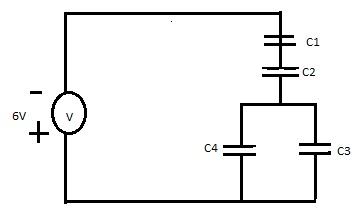A circuit consisting of a 6.0 V battery and four capacitors is constructed as follows. The negative terminal of the bat- tery leads to C1 = 34 µF, which is connected in series with C2 = 40 pF. After C2, the wiring branches into two paths: one path contains C3 = 45 µF, the other contains C4 = 50 pF. (I.e., C3 and C4 are in parallel with each other.) The wiring then recombines and leads back to the positive terminal of the bat- tery. Determine the amount of charge Q1 on each plate of C1 after a long time has passed. For your limit check, investigate what happens to Qi as C2, C3, and C4 all approach infinity. (Remember to work symbolically for this entire problem.) %3D
A circuit consisting of a 6.0 V battery and four capacitors is constructed as follows. The negative terminal of the bat- tery leads to C1 = 34 µF, which is connected in series with C2 = 40 pF. After C2, the wiring branches into two paths: one path contains C3 = 45 µF, the other contains C4 = 50 pF. (I.e., C3 and C4 are in parallel with each other.) The wiring then recombines and leads back to the positive terminal of the bat- tery. Determine the amount of charge Q1 on each plate of C1 after a long time has passed. For your limit check, investigate what happens to Qi as C2, C3, and C4 all approach infinity. (Remember to work symbolically for this entire problem.) %3D
Introductory Circuit Analysis (13th Edition)
13th Edition
ISBN:9780133923605
Author:Robert L. Boylestad
Publisher:Robert L. Boylestad
Chapter1: Introduction
Section: Chapter Questions
Problem 1P: Visit your local library (at school or home) and describe the extent to which it provides literature...
Related questions
Question
100%
Please answer the question and show how you arrive there. Also why does the result of the limit check make physical sense?

Transcribed Image Text:A circuit consisting of a 6.0 V battery and four capacitors
is constructed as follows. The negative terminal of the bat-
tery leads to Cı
C2 = 40 pF. After C2, the wiring branches into two paths: one
path contains C3 = 45 µF, the other contains C4 = 50 µF. (1.e.,
C3 and C4 are in parallel with each other.) The wiring then
recombines and leads back to the positive terminal of the bat-
tery. Determine the amount of charge Q1 on each plate of C1
after a long time has passed. For your limit check, investigate
what happens to Q1 as C2, C3, and C4 all approach infinity.
(Remember to work symbolically for this entire problem.)
34 pF, which is connected in series with
Expert Solution
Step 1
As per the description, the connection diagram can be like the one shown below.

Trending now
This is a popular solution!
Step by step
Solved in 4 steps with 2 images

Knowledge Booster
Learn more about
Need a deep-dive on the concept behind this application? Look no further. Learn more about this topic, electrical-engineering and related others by exploring similar questions and additional content below.Recommended textbooks for you

Introductory Circuit Analysis (13th Edition)
Electrical Engineering
ISBN:
9780133923605
Author:
Robert L. Boylestad
Publisher:
PEARSON

Delmar's Standard Textbook Of Electricity
Electrical Engineering
ISBN:
9781337900348
Author:
Stephen L. Herman
Publisher:
Cengage Learning

Programmable Logic Controllers
Electrical Engineering
ISBN:
9780073373843
Author:
Frank D. Petruzella
Publisher:
McGraw-Hill Education

Introductory Circuit Analysis (13th Edition)
Electrical Engineering
ISBN:
9780133923605
Author:
Robert L. Boylestad
Publisher:
PEARSON

Delmar's Standard Textbook Of Electricity
Electrical Engineering
ISBN:
9781337900348
Author:
Stephen L. Herman
Publisher:
Cengage Learning

Programmable Logic Controllers
Electrical Engineering
ISBN:
9780073373843
Author:
Frank D. Petruzella
Publisher:
McGraw-Hill Education

Fundamentals of Electric Circuits
Electrical Engineering
ISBN:
9780078028229
Author:
Charles K Alexander, Matthew Sadiku
Publisher:
McGraw-Hill Education

Electric Circuits. (11th Edition)
Electrical Engineering
ISBN:
9780134746968
Author:
James W. Nilsson, Susan Riedel
Publisher:
PEARSON

Engineering Electromagnetics
Electrical Engineering
ISBN:
9780078028151
Author:
Hayt, William H. (william Hart), Jr, BUCK, John A.
Publisher:
Mcgraw-hill Education,